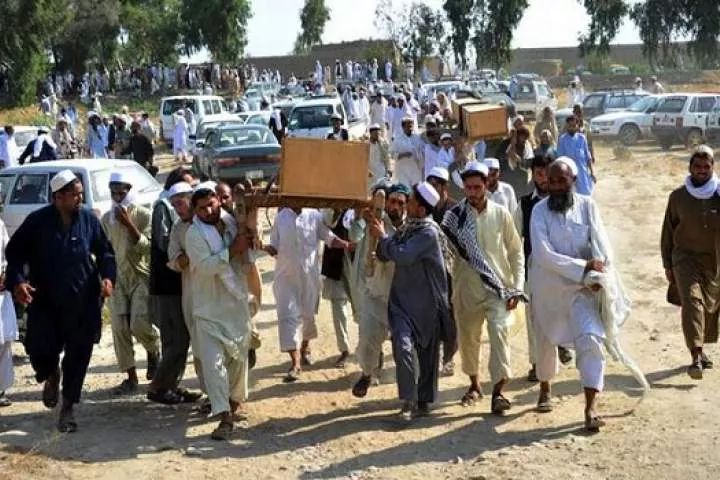While President Trump was in Afghanistan celebrating Thanksgiving, a US drone strike there reportedly killed a woman who had just given birth hours before. It also killed four more civilians.
The incident was not an anomaly: it was indicative of the significant uptick in civilian casualties from US drone strikes in Afghanistan lately. In early October, the United Nations Assistance Mission in Afghanistan reported that in May, at least 30 civilians, including children, had been killed by US forces in airstrikes on alleged drug labs in western Afghanistan. The US claimed the victims were all Taliban fighters, but it never produced any evidence.
It is not surprising to see the number of civilians killed and wounded by US forces is up in Afghanistan, given the uptick in bombings: the US dropped more bombs in September 2019 than at any point since October 2010.
Yet as the Special Inspector General for Afghanistan Reconstruction testified at a hearing on Wednesday in the House Foreign Affairs Committee, the US military continues to hide evidence of the impact.
“The Washington Post’s” recent publication of The Afghanistan Papers was shocking [shocking] not for the revelation that the US wasn’t “winning” its war in Afghanistan, so much as for the depth of the deception US officials engaged in to hide their losses.
Sadly, that deception echoes what Amnesty International has confronted for years in documenting civilian casualties caused by US actions: regardless of the strength of our evidence, collected from extensive interviews, satellite imagery, and forensic evidence found at strike sites, the military generally denies them.
Even if it promises to investigate, the military is let off the hook: it never has to demonstrate that it conducted a meaningful investigation, produce the results, or acknowledge what went wrong.
Congress thankfully stepped in to try to change that. In the 2020 National Defense Authorization Act, Congress requires both the military and the Central Intelligence Agency to improve investigation and reporting of civilian casualties caused by their operations.
The military spending bill instructs the Defense Department to study and report the “lessons learned” of the battles against the armed group calling itself “Islamic State” in Raqqa and Mosul, which killed thousands of civilians; study how the US investigates and responds to civilian casualties, and the resources needed to improve that; creates a fund for payments to victims and survivors; and mandates interagency cooperation in receiving and responding to complaints of civilian harm brought by people directly affected on the ground.
The problem we’ve seen is more than just the US failure to provide information about who it’s killing and why; it’s that we don’t even know whether the US is investigating claims of civilians killed in any meaningful way. As a result, we don’t know if the US is learning how to protect civilians from US bombings better next time.
Amnesty has investigated the impact of US lethal airstrikes on the ground in Syria, Iraq, and Somalia. Each time, we present our evidence to the US government, and it promises to investigate.
Occasionally, the military acknowledges it killed civilians — sometimes, as in Syria, after initially dismissing the claims as “not credible.” But when we followed up our initial reporting in Syria documenting nearly 100 civilians killed in a 4-month battle with our conclusion after months more research that the US-led Coalition killed 1,600 civilians, the response was radio silence.
At other times, the US response has been a flat denial. After Amnesty documented 17 civilians killed and eight injured from six US airstrikes in Somalia, the US military responded that all the dead were fighters, or “affiliates of” enemy fighters.
We never received any evidence or explanation of what would deem someone an “affiliate” or why the US government thought it was lawful to kill “affiliates” of enemy armed groups. After all, under the laws of war, it is unlawful.
As the US continues its so-called “war on terror” around the world, it matters a great deal exactly how it fights its battles, and what steps it takes to protect civilians on the ground. Does it use heavy munitions and explosive weapons in urban areas, for example? How much care does it take to ensure the reliability of its local intelligence sources? Do US forces make sure there’s a way for civilians to escape the bombardment?
It’s essential to know how many civilians were killed or wounded in any particular battle for many reasons: to understand how best to protect civilians and help survivors and their families; to hold individuals accountable if their actions broke the law, and to help the military learn from its mistakes if that’s what they were.
But if it’s only conducting cursory investigations, reviewing the evidence it already has, rather than seeking new information from witnesses and survivors of the strikes, then it won’t know how to protect civilians better next time.
The Department of Defense says it wants to improve its civilian casualties’ response, and it’s an important step forward that Congress will now require it to do so. But it’s not enough to legislate. Congress now has to make sure the Trump administration fulfills the law’s requirements.
